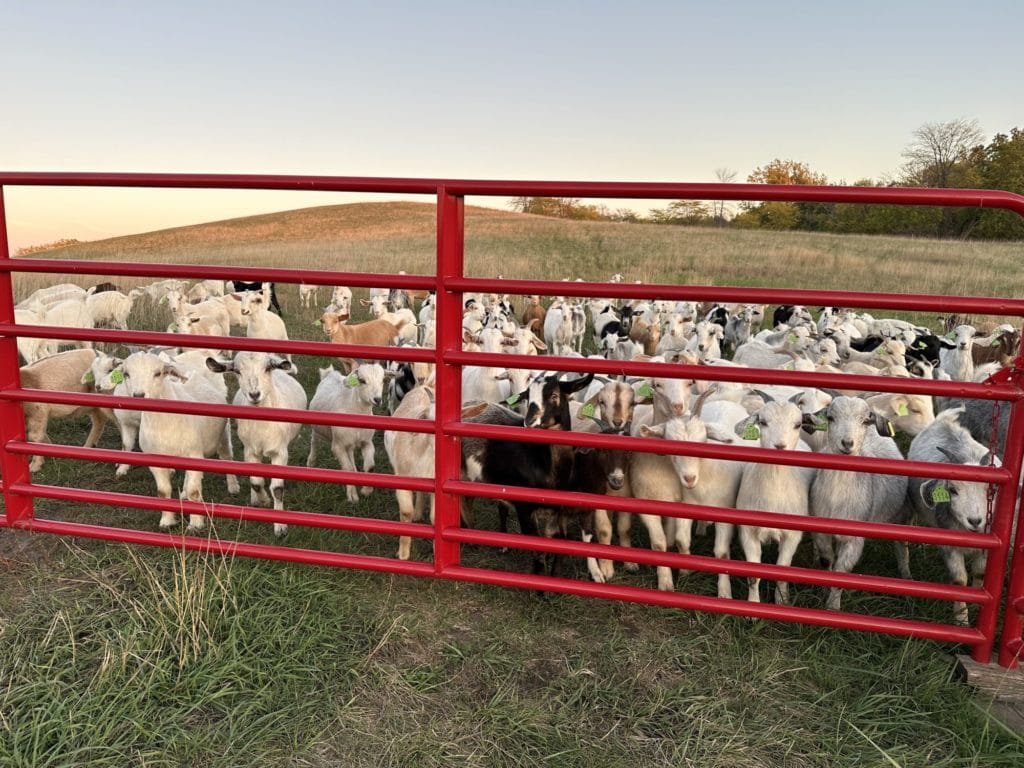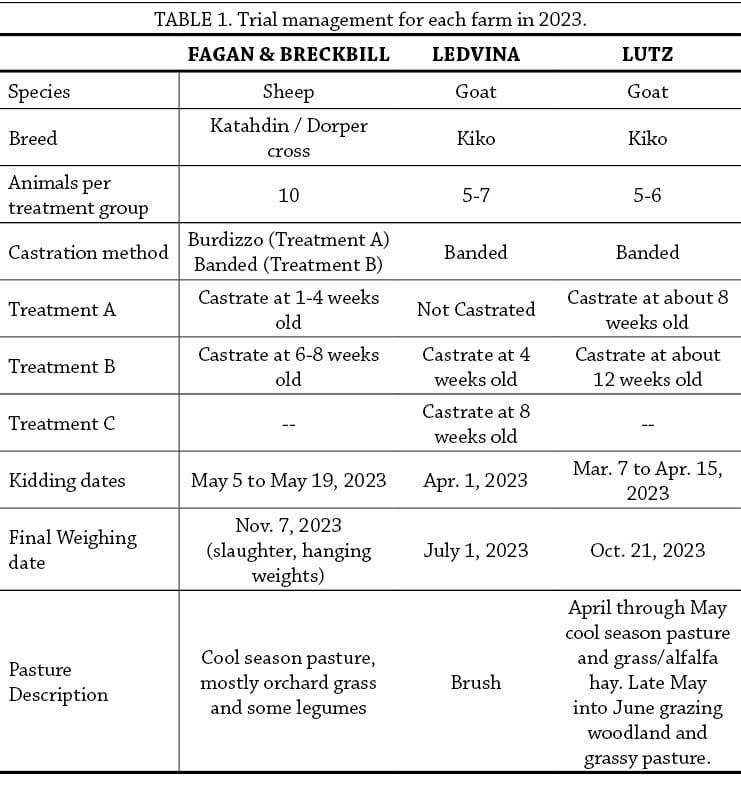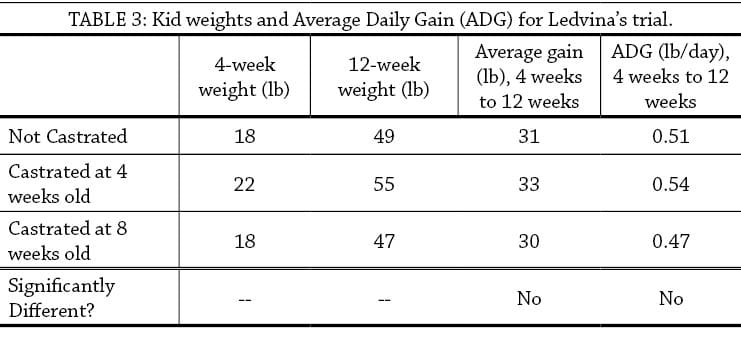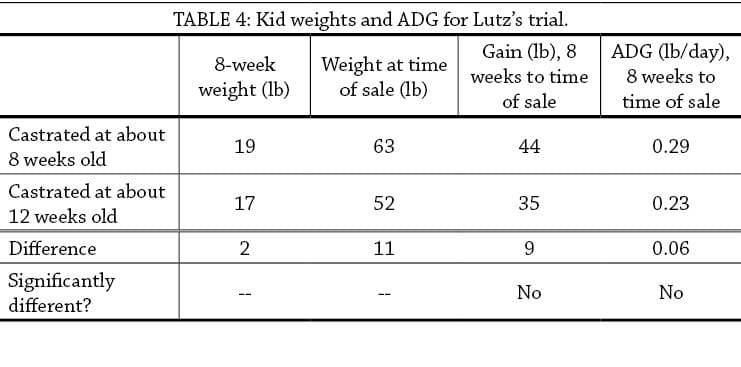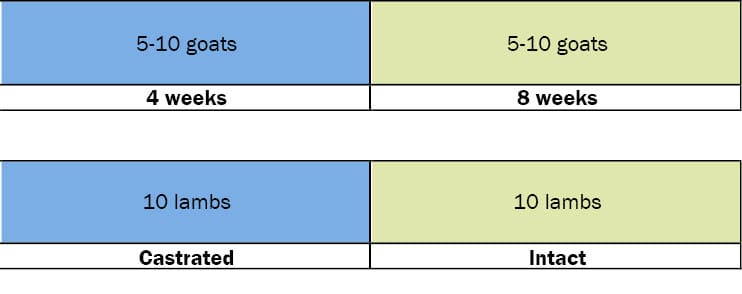This research was funded by the Walton Foundation.
In a Nutshell:
• Lamb and kid castration timing may affect animal health and wellbeing, final hanging weights, and labor timing and costs.
• Adam Ledvina and Bailey Lutz tested whether castrating goat kids at 4 weeks vs. 8 weeks affected goat weight. Ledvina also included an uncastrated kid treatment. Emily Fagan and Hannah Breckbill assessed whether castrating lambs at 1-4 weeks old vs. 6-8 weeks old affected final hanging weights.
Key Findings:
• Kid and lamb age at castration did not affect kid average daily gains (Ledvina and Lutz) or lamb final weight (Fagan & Breckbill). All the animals were healthy throughout the trial.
Background
Castration of goat kids and lambs is a common practice but there are no set regulations on this procedure in the US. Farmers commonly perform castration on animals anywhere from one or two days old to several months old. Castration affects the animal’s hormones and therefore growth rate, meat fattiness, and some physical development factors such as urethra size. Cooperators Emily Fagan & Hannah Breckbill, Adam Ledvina and Bailey Lutz wondered if the timing of kid or lamb castration would affect the final hanging weights of their animals or the general health in their herds. Ledvina and Lutz assessed average daily gain (ADG) and health differences in kids castrated at four weeks or eight weeks old (Ledvina) and eight or twelve weeks old (Lutz), while Fagan & Breckbill assessed differences in lambs castrated at 1-4 or 6-8 weeks old. Lutz commented that “This trial will influence financial viability by determining the impact of castration on the growth and thus the financial yield of each goat. Additionally, I can see it influencing labor (which also impacts financial viability) by helping to determine how important the timing of castration is.” Fagan & Breckbill also hoped to “learn a lot about how boy sheep grow and gain weight, which will help us on the way to being more profitable with our sheep production.”
One common reason for delaying castration until animals are several months old is that castration when the animals are young leads to them having narrower urethras later in life [1], [2]. This has been associated with increased rates of urinary calculi, mineral deposits that block the urethra and prevent animals from peeing. However, animal welfare and veterinary sources agree that castration while animals are very young is safe as long as the animals are consuming feed or forage that has proper ratios of calcium to potassium [3]. Feed marketed for goats and sheep and most forage sources meet these criteria. Ledvina noted that “this trial may help show whether kidney stones could be a problem or not with timing of castration.”
Methods
Design
Trial management factors including species, castration method, feed type unique to each farm are shown in Table 1. Cooperators used different castration treatment ages based on their existing castration practices and preferences. Kids and lambs were born on-farm and assigned to castration timing treatments at the time of the first treatment (Table 1, Figure A1). Fagan & Breckbill and Lutz intentionally split twin boys into different castration treatments and otherwise randomly divided animals into castration groups. Ledvina randomly divided kids into treatments. All cooperators kept track of individual animals with numbered ear tags. Apart from the castration treatments, all goats were managed similarly: raised on pasture and receiving equal access to feed and water.
Measurements
All cooperators tracked goat or lamb day of birth and slaughter dates. Ledvina and Lutz recorded the weight of each individual goat from each of the two groups at about 4, 8, and 12 weeks old. Lutz also weighed the animals at birth. Average daily gains (ADG) were calculated from weights and animal ages. Fagan & Breckbill reported final hanging weights provided by processor. Cooperators also noted any illnesses in animals.
Data analysis
We used Fischer’s LSD at a 90% confidence level to determine if there were significant differences in average daily gain or final hanging weight by castration treatment. For each metric, the difference between any two treatments is compared with the LSD. A difference greater than or equal to the LSD indicates the presence of a statistically significant treatment effect, meaning one treatment outperformed the other and the farmer can expect the same results to occur 90 out of 100 times under the same conditions. A difference smaller than the LSD indicates the difference is not statistically significant and the treatment had no effect. We can perform this analysis because the cooperators had completely randomized and replicated experimental designs (Figure A1).
Results and Discussion
None of the cooperators found that castration affected lamb final hanging weight (Fagan & Breckbill)(Table 2) or goat ADG (Ledvina and Lutz)(Tables 3 and 4). Lutz weighed their kids on four dates (at birth, at 8 week castration treatment, at 12 week castration treatment, at time of sale) and found no differences in ADG of castration treatment groups within any of these time periods. ADG between 8-week castration treatment to time of sale is shown in Table 4 for comparability with Ledvina’s data. No one observed differences in animal health or health issues related to castration between the treatments, either. Fagan reports that the cooperators “learned that different castration timing doesn’t matter as much as I thought it might.”
Ledvina was especially interested to find that his uncastrated treatment group had no differences in ADG compared to the two castration treatments (Table 3). “Many assume leaving bucks intact results in higher growth rates, but this test proved overwise,” he said. Recent academic literature has similarly found that castration timing [5] and castration vs. leaving intact [4] does not affect goat growth rate though these studies castrated much older goats (3-6 months) than the cooperators in this trial did.
Conclusions and Next Steps
No farms found any differences in animal yield metrics or animal health by castration timing. Ledvina and Fagan agreed that they will now probably stick with an early castration date – Ledvina to “prevent any accidental breeding,” and Fagan because “it’s easier to handle the lambs, and to do the castration itself [at an earlier date].” Lutz still wants to experiment further with what castration timing will work best on their operations. All three cooperators were happy to have answered some questions through this trial and were eager to continue experimenting with their livestock methods. Ledvina calls for “more farms to participate in these sorts of trials!”
Appendix – Trial Design and Weather Conditions
References
- Z. Bani Ismail, M. Al-Zghoul, A. Al-Majali, and N. Khraim, “Effects of castration on penile and urethral development in Awassi lambs,” Bulg. Vet. J., vol. 10, pp. 29–34, Jan. 2007.
- S. LeValley and B. Kirch, “Urinary Calculi in Wether Lambs/Kids,” no. Factsheet No. 1.629, Aug. 2010. [Online]. Available: https://extension.colostate.edu/docs/pubs/livestk/01629.pdf
- A. Bassett, “Urinary Calculi in Goats.” A Greener World, 2009. Accessed: Sep. 29, 2023. [Online]. Available: https://agreenerworld.org/wp-content/uploads/2018/05/TAFS-3-Urinary-Calculi-in-Goats-v1.pdf
- M. J. Zamiri, B. Eilami, and M. R. Kianzad, “Effects of castration and fattening period on growth performance and carcass characteristics in Iranian goats,” Small Rumin. Res., vol. 104, no. 1, pp. 55–61, May 2012, doi: 10.1016/j.smallrumres.2011.11.008.
- Y.-A. Chen, J.-Y. Chen, W.-Q. Chen, W.-Y. Wang, and H.-H. Wu, “Effects of Castration Age on the Growth Performance of Nubian Crossbred Male Goats,” Anim. Open Access J. MDPI, vol. 12, no. 24, p. 3516, Dec. 2022, doi: 10.3390/ani12243516.


